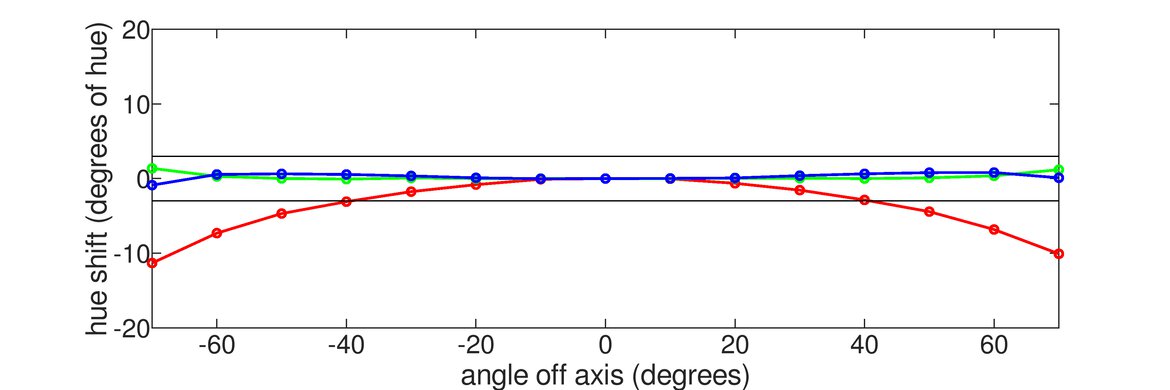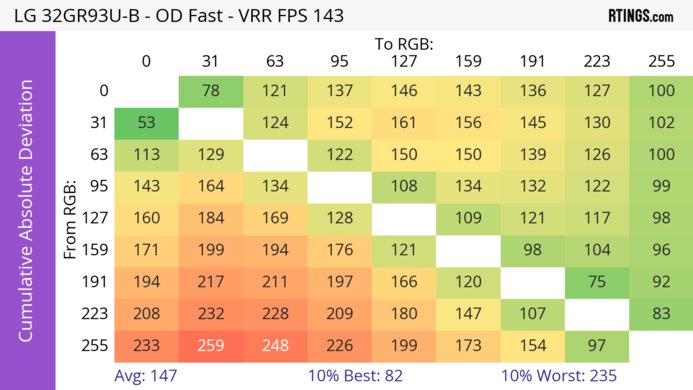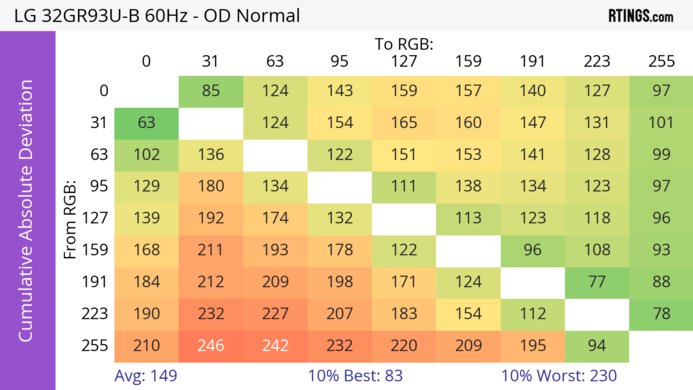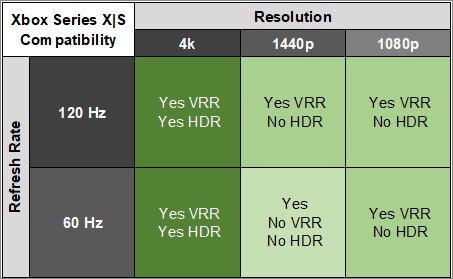The LG 32GR93U-B is a mid-range 4k, 144Hz gaming monitor. Part of the UltraGear gaming lineup, it's a newer and lower-end model than the LG 32GQ950-B with a lower 144Hz refresh rate, and it sits alongside the LG 27GR93U-B. It's designed with console gaming in mind, as it has HDMI 2.1 bandwidth that can take full advantage of the PS5 and Xbox Series X|S. It also has FreeSync variable refresh rate (VRR) support and G-SYNC compatibility to reduce screen tearing. It has a few inputs to connect your devices, including an audio port that supports DTS Headphone:X audio, but other than that, it's limited in many extra features.
Our Verdict
The LG 32GR93U-B is decent for PC gaming. Some competitive gamers may find its 144Hz refresh rate limiting, but it supports HDMI 2.1 bandwidth and all common VRR formats to reduce screen tearing. Luckily, it has low input lag for a responsive feel, and it has a fast response time that remains consistent across its VRR range, resulting in sharp motion. Unfortunately, though, it has a low contrast ratio that makes blacks look gray, so it isn't ideal for dark room gaming as it has limited picture quality.
- Consistently fast response time.
- Supports all common VRR formats.
- Low input lag.
- Low contrast ratio.
- Highlights don't pop against the rest of the image.
The LG 32GR93U is great for console gaming. It takes full advantage of the Xbox Series X|S and PS5 and delivers detailed images thanks to its HDMI 2.1 bandwidth. Gaming feels responsive due to its low input lag, and it has a fast response time at 120Hz and 60Hz for sharp motion. Sadly, it's a disappointing choice if you want realistic images, as it has limited picture quality due to its low contrast and lack of local dimming.
- HDMI 2.1 bandwidth.
- Consistently fast response time.
- Low input lag.
- Low contrast ratio.
- Highlights don't pop against the rest of the image.
The LG 32GR93U is great for the office. Its large 32-inch screen is ideal for multitasking with different windows open, and it has high pixel density to produce sharp and clear text. It gets bright enough to use in a well-lit room, but reflections are distracting. It also has wide enough viewing angles to share your screen with someone else, but the stand doesn't offer swivel adjustment to turn the display.
- Sharp text and image clarity.
- Great peak brightness.
- Decent viewing angles.
- No swivel adjustment.
- Limited in extra office features.
Disappointing reflection handling.
The LG 32GR93U is good for media creation. It has a large screen that makes it easier to multitask or view more of your work area at once, and its 4k resolution helps deliver high pixel density and sharp text clarity. It also has an extremely accurate sRGB mode, so you won't need to calibrate it for accurate colors. Lastly, its wide viewing angles are great if you need to share your screen with a coworker or client, but without swivel adjustments on the stand, it's difficult to turn the screen.
- Sharp text and image clarity.
- Great peak brightness.
- Decent viewing angles.
- Extremely accurate sRGB mode.
- No swivel adjustment.
- Limited in extra office features.
- Low contrast ratio.
The LG 32GR93U has good brightness. It easily gets bright enough to fight intense glare in well-lit rooms, but it doesn't make small highlights pop in HDR.
- Great peak brightness.
- Highlights don't pop against the rest of the image.
The LG 32GR93U has a great overall response time. It maintains a consistently fast response time across its refresh rate range, but it doesn't eliminate all blur and inverse ghosting.
- Consistently fast response time.
The LG 32GR93U is terrible for HDR. It has a low contrast ratio that makes blacks look gray, and it lacks a local dimming feature to further improve the picture quality. It also struggles to make colors look vivid and highlights pop.
- Low contrast ratio.
- No local dimming feature.
The LG 32GR93U has decent picture quality in SDR. While it displays a wide range of colors, it has limited picture quality due to its low contrast, which makes blacks look gray.
- Displays wide range of colors.
- Low contrast ratio.
The LG 32GR93U has amazing color accuracy. It has fantastic accuracy before calibration in its dedicated sRGB mode, and calibrating it doesn't significantly improve color accuracy. It also has good gray uniformity that keeps the image consistent throughout most of the screen, but the edges are darker.
- Extremely accurate sRGB mode.
- Good gray uniformity.
Performance Usages
Changelog
- Updated Nov 10, 2025: We've converted this review to Test Bench 2.1.1. We removed the Vertical Viewing Angle test.
-
Updated Jun 25, 2025:
We updated text throughout to match the new and updated tests with Test Bench 2.1, including in the Verdict section.
- Updated Jun 25, 2025: We've converted this review to Test Bench 2.1. This includes new tests for Direct Reflections, Ambient Black Level Raise, and Total Reflected Light. You can see all the changes in the changelog.
-
Updated May 09, 2025:
Added that the Samsung Odyssey G70D S32DG70 has a remote control.
Check Price
Differences Between Sizes And Variants
We tested the 32-inch LG 32GR93U, and the results are only valid for this review. While the 27-inch LG 27GR93U-B is also available, it's a separate monitor.
| Model | Size | Panel Type | Resolution | Max Refresh Rate |
|---|---|---|---|---|
| 32GR93U-B | 32" | IPS | 4k | 144Hz |
Our unit was manufactured in June 2023; you can see the label here. The first unit we bought broke in April 2024 after finishing testing and using it for some time. Lines started appearing on the screen, and it didn't show an image at times. We bought a second unit, which we confirmed performs the same as the first unit, but the results in the review are all from the original unit.
Popular Monitor Comparisons
The LG 32GR93U is a good all-around monitor that offers HDMI 2.1 bandwidth for console gaming, and its fast response time makes motion look sharp, even better than the LG 27GR93U-B. Because of this, it offers almost anything a gamer would want in a 4k, 144Hz monitor, and it's a good alternative to the more expensive LG 32GQ950-B, which doesn't offer much improvement in terms of performance. However, other higher refresh rate monitors are available for PC gaming, and this monitor doesn't have as many productivity features as the Gigabyte M32U.
See our recommendations for the best 4k gaming monitors, the best 4k 144Hz monitors, and the best 32-inch monitors.
The Gigabyte M32U and the LG 32GR93U-B are both decent 4k gaming monitors. They perform similarly, but there are a few differences. The LG has a slight advantage in gaming as it has a faster response time across its entire refresh rate range and a slightly lower input lag. However, the Gigabyte has more extra features, like a KVM switch and USB-C port, making it easier to multitask with different devices. The Gigabyte also has a more ergonomic stand that offers swivel adjustment, so it's easier to share your screen with someone else.
The Dell G3223Q and the LG 32GR93U-B are both good 4k, 144Hz gaming monitors. They perform very similarly, but the LG has a slight advantage when gaming at 60Hz as it has a faster response time and lower input lag. The Dell has a more accurate sRGB mode, but the LG is still accurate regardless. Besides that, both monitors are very similar, and you'll be happy with either.
The LG 32GR93U-B and the Samsung Odyssey G70D S32DG70 are both 32-inch, 4k gaming monitors. The LG is the better option for most people, as it displays deeper blacks and a wider range of colors more accurately. However, if you want to use your monitor like a TV the Samsung is a better option, as it has a smart OS and a remote.
The LG 32GQ950-B is a higher-end monitor than the LG 32GR93U-B, but both monitors perform similarly. The main difference is that the 32GQ950-B has an overclock feature to boost its refresh rate up to 160Hz, but it doesn't work on all devices. The 32GQ950-B also has a local dimming feature, which the 32GR93U-B doesn't have, and while it helps improve the HDR brightness, it performs terribly overall.

We buy and test more than 30 monitors each year, with units that we buy completely on our own, without any cherry-picked units or samples. We put a lot into each unbiased, straight-to-the-point review, and there's a whole process from purchasing to publishing, involving multiple teams and people. We do more than just use the monitor for a week; we use specialized and custom tools to measure various aspects with objective data-based results. We also consider multiple factors before making any recommendations, including the monitor's cost, its performance against the competition, and whether or not it's easy to find.
Test Results

The LG 32GR93U has a rather simple design with a dark gray body. The back features a honeycomb pattern, and it has some RGB lighting that you can change with presets.
The build quality is good, and there aren't any obvious issues. It's mainly made of plastic that feels solid, and it doesn't flex easily. The stand also supports the screen well, and while it wobbles a bit, it quickly stabilizes itself.
The first unit we bought broke in April 2024 after finishing testing and using it for some time. Lines started appearing on the screen, and it didn't show an image at times. Others have reported similar issues, so if you experience the same thing, let us know in the Comments.
We bought a second unit, which we confirmed performs the same as the first unit, but the results in the review are all from the original unit.
The LG 32GR93U has decent ergonomics, but you can't swivel it to show the screen to someone next to you. You can only rotate it into portrait mode in a clockwise direction, which means the inputs are always on top. The stand also has a clip for cable management.
A single joystick is underneath the center of the screen to control the on-screen display. If you'd like a monitor that you can control from the the other side of your room, check out the Samsung Odyssey G70D S32DG70, which has a remote control and smart OS.
This monitor doesn't have a local dimming feature. Although it has a Variable Backlight setting, it only boosts the contrast level in HDR and doesn't turn off any dimming zones. We still film these videos on the monitor so you can compare the backlight performance with a monitor that has local dimming.
The SDR brightness is great. It easily gets bright enough to fight glare and maintains its brightness consistently across different content. Unfortunately, its minimum brightness is high, which is disappointing if you want to use it in a dark room and you're sensitive to bright lights. These results are from after calibration in the 'Gamer 1' Game Mode with the Brightness at its max.
The HDR brightness is decent. While it gets bright, small highlights don't pop against the rest of the image because it lacks a local dimming feature. The EOTF is also terrible as dark scenes are over brightened, and it has an early roll-off, so highlights don't get very bright. These results are in the 'Gamer 1' Game Mode with the Brightness at its max.
The LG UltraGear 32GR93U-B has fantastic accuracy before calibration in the sRGB mode. Most colors and the white balance are only slightly inaccurate, and the color temperature is very close to the 6500K target. Even gamma follows the target sRGB curve well, but dark scenes are too dark, and bright scenes are too bright. Unfortunately, the 'sRGB' Game Mode locks many settings, including Response Time, so if you want to use any of those settings, you'd have to use another picture mode that has oversaturated colors, as you can see here.
The accuracy after calibration is incredible. While the accuracy is already fantastic before calibration, the main advantage of calibrating it is that you can use the settings that are locked out in the sRGB mode, like the gaming settings.
The SDR color gamut is incredible. It has perfect coverage of the common sRGB color space, and while it's also excellent with the Adobe RGB color space, it oversaturates magenta and red, and green is inaccurate.
The HDR color gamut is superb. It displays a wide range of colors in the common DCI-P3 and wider Rec. 2020 color spaces, but it struggles with tone mapping in each, as most colors are off.
The horizontal viewing angle is decent. It's fine if you need to share the screen with someone right next to you, but it gets darker at wide angles.
The text clarity is fantastic. Its high pixel density helps result in sharp text, and enabling Windows ClearType (top photo) improves the clarity. These photos are in Windows 10, and you can see them in Windows 11 with ClearType on and with ClearType off.
The direct reflection handling is disappointing. Even with a matte coating that spreads light out, it has some mirror-like reflections.
The black levels on this monitor don't rise much in bright rooms. However, because of its low contrast ratio, blacks still look gray.
To reach the monitor's max refresh rate over DisplayPort, your graphics card needs to support Display Stream Compression (DSC), which any NVIDIA 16 Series or AMD RX 5000 Series and newer graphics card supports. You can disable DSC over DisplayPort by changing Input Compatibility to '1.4,' but that limits the refresh rate. You can reach 120Hz with chroma 4:2:2 with this setting, though.
| NVIDIA | VRR Min | VRR Max |
| DisplayPort | <20Hz | 144Hz |
| HDMI | <20Hz | 144Hz |
| AMD | VRR Min | VRR Max |
| DisplayPort | <20Hz | 144Hz |
| HDMI | <20Hz | 144Hz |
On top of FreeSync support and G-SYNC compatibility, the monitor supports HDMI Forum VRR.
| Refresh Rate | CAD Heatmap | RT Chart | Pursuit Photo |
| 143 | Heatmap | Chart | Photo |
| 120 | Heatmap | Chart | Photo |
| 100 | Heatmap | Chart | Photo |
| 80 | Heatmap | Chart | Photo |
| 60 | Heatmap | Chart | Photo |
The LG 32GR93U-B has great motion handling across its entire refresh rate range with VRR enabled. The 'Off,' 'Normal,' and 'Fast' Response Time settings all perform similarly, but 'Fast' is the best for most refresh rates. That said, 'Normal' is more consistent over the entire refresh rate range and has lower CAD at lower frame rates. The 'Faster' Overdrive setting performs so badly that it passes the limits of the graph, as you can see here.
The refresh rate compliance is good. Although its response time struggles to keep up with its max refresh rate, this is typical of most LCD monitors, and it gets better with lower frame rates. The 'Off,' 'Normal,' and 'Fast' Overdrive settings are all similar, but 'Faster' has much worse compliance.
| Overdrive Mode | CAD Heatmap | RT Chart | Pursuit Photo |
| Off | Heatmap | Chart | Photo |
| Normal | Heatmap | Chart | Photo |
| Fast | Heatmap | Chart | Photo |
| Faster | Heatmap | Chart | Photo |
The CAD at the max refresh rate is very good. Although there's a bit of smearing and blur, it isn't overly distracting. While the 'Normal' and 'Fast' Overdrive settings have similar CAD, motion is just a bit sharper with 'Fast.' However, the 'Faster' Overdrive setting has too much overshoot, causing inverse ghosting.
| Overdrive Mode | CAD Heatmap | RT Chart | Pursuit Photo |
| Off | Heatmap | Chart | Photo |
| Normal | Heatmap | Chart | Photo |
| Fast | Heatmap | Chart | Photo |
| Faster | Heatmap | Chart | Photo |
The CAD at 120Hz is great. The motion looks sharp without too much distracting blur. The 'Normal' and 'Fast' Overdrive settings perform similarly, but 'Fast' has slightly lower CAD and has less inverse ghosting than 'Faster.'
| Overdrive Mode | CAD Heatmap | RT Chart | Pursuit Photo |
| Off | Heatmap | Chart | Photo |
| Normal | Heatmap | Chart | Photo |
| Fast | Heatmap | Chart | Photo |
| Faster | Heatmap | Chart | Photo |
The CAD at 60Hz is good. Although there's a bit of inverse ghosting, it's minimal and hard to see. Unlike at higher refresh rates, the recommended Overdrive setting is 'Normal' because 'Fast' has too much overshoot.
This monitor has no optional backlight strobing feature to reduce persistence blur.
The LG 32GR93U has low input lag for a responsive feel while gaming.
This monitor works well with the Xbox Series X|S, but you need to enable the HDMI override setting for 1440p @ 60Hz to work, which also disables VRR. Keep in mind that the console doesn't support HDR with 1080p or 1440p signals, so this isn't a limitation of the monitor.
The 3.5 mm audio output serves as a combo jack with audio out and mic in, but you need to have the USB-B cable connected to your computer to fully use it. It also comes with DTS Headphone:X to simulate surround sound audio.
The LG 32GR93U-B has no USB-C ports, but if you're looking for a monitor with a USB-C hub, you may want to consider the Lenovo Legion Y32p-30.
This monitor works well with macOS. Using a DisplayPort to USB-C cable, VRR and HDR work simultaneously, and there aren't any compatibility issues. If you're using a MacBook, windows return to their original position when reopening the lid or waking the laptop up from sleep. However, if you're using the 2023 M2 MacBook Pro with HDMI, the max refresh rate is 144Hz without VRR, as you can only get up to 120Hz with VRR. Also, you need to make sure the monitor's Input Version setting is set to 'PC.'
The LG 32GR93U has a few extra features, including:
- Black Stabilizer: Adjusts the gamma so that it's easier to see opponents in dark areas.
- Crosshair: Adds a virtual crosshair that your game's anti-cheat tool won't detect, giving you a competitive advantage.
- DFC: Changes the contrast based on the content.
- Hexagon Lighting: This is the setting to adjust the RGB lighting on the back of the monitor.
- Variable Backlight: Boosts the contrast level in HDR, but it isn't a local dimming setting.
































































